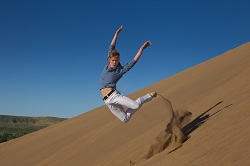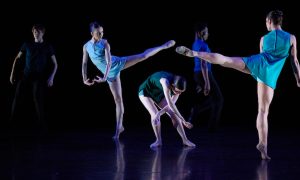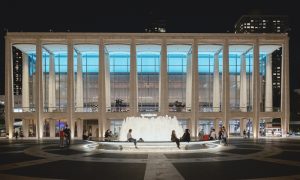“It’s not enough to make great art. It has to be something bigger.”
By Stephanie Wolf.
What is contemporary dance? This question stumps even the most notable of dance professionals. With no concrete answer, the definition is left up to the interpretation of the artists who are at the cutting-edge of the American contemporary dance scene. Whether it be a cross-discipline collaboration, an exploration of human emotion, or a commentary on popular culture, contemporary dance is designed to be relevant and thought-provoking—it makes us think of art in terms of life, and life in terms of art.
There are a number of individuals and organizations coming to the forefront of this dance progression; these are artists who have decided to carve out their own destiny in the nation’s dance profession rather than taking their innovative work to larger, already established companies. One of these dance visionaries is Trey McIntyre, who in 2005 began an artistic pursuit that is now known as the Trey McIntyre Project (TMP). Currently, the troupe is a full-time company, residing in Boise, ID and delighting audiences around the world.
“There was an evolution in American dance, at the time. [McIntyre] said he was interested in taking his art further…to go to a deeper level,” says TMP’s Executive Director and Co-Founder John Michael Schert in regards to the initial motivation to start a new dance company. Having been a part of the vision since the beginning, Schert has watched the company grow from a four-week summer residency in White Oak, Florida to a fully-fledged American dance staple.
Three “precocious and ambitious” individuals, McIntyre, Schert, and former Oregon Ballet Theatre dancer Anne Mueller, set out to get TMP off the ground and running. “We had zero training in putting a dance company together…and learned as we went.” For the first summer, McIntyre assembled a “dream team” of “like-minded” creative individuals from around the U.S. including dancers from Washington Ballet, Oregon Ballet Theatre, and Ballet Memphis. He had been the resident choreographer for all of these companies.

Dancer Benjamin Behrends of Trey McIntyre Project. Photo by Lois Greenfield
In the beginning, TMP spent four weeks in Florida performing for audiences in the Jacksonville, FL area and touring to dance landmarks like the Vail International Dance Festival (where the company debuted), Aspen, Jacob’s Pillow, Wolf Trap, and Boise, ID. In 2008, at the height of the nation’s recession, TMP became a full time company, finding an artistic home in Boise and hiring a “young crop of unbelievable dancers.”
With the weighty implications brought on by a struggling economy and declining funding for the arts, McIntyre and his colleagues got to the root of their mission quickly. They made it their goal to stay true and authentic to the belief that “it’s not enough to make great art. It has to be something bigger.”
Emphasizing an optimistic outlook, Schert believes it’s a great time to be an American contemporary dance company. He sees only “opportunities” rather than challenges. This doesn’t mean the company is entirely unaffected by difficult economic times. To ensure perseverance, TMP organizes a “very diversified” stream of financial support through local and national funding and grants. This positivity and resourcefulness has allowed the company to build a unique, strong business model and to grow every year in both its budget and capabilities.
So, how does an internationally touring contemporary dance company come to call Boise, ID home? Initially, Boise wasn’t necessarily the front-runner for an artistic and administrative base. McIntyre and Schert looked at many cities in which McIntyre had personal connections. They weighed in on numerous variables: audience and ticket sale potential, fundraising potential, community involvement, etc. With all of these factors in mind, Boise began to emerge as a viable and surprising prospect.
“It’s a city [in which] we can really be a part of the fabric of the community, we can make more of an impact.” Additionally, Boise is coming at a “defining era in time.” Boise is investing “their energy, support, and funding in how they present themselves as a creative city.” This artistic investment makes for a great match with TMP’s ambitions in both creative and business terms.
As the company’s mission statement expresses, it’s not enough to exist only as a performance group. Every day, TMP strives “to enhance the audience experience and engage and educate whole communities [through] face-to-face relationships.” TMP is a large part of the Boise community, involved in local initiatives, outreach programs, and businesses.
Schert also speaks passionately on what makes TMP unlike any other American contemporary dance company. “Trey is creating a whole new way of being. The work is highly emotional, but not melodramatic. There’s not necessarily a plot, but there is an emotional narrative – there’s no right or wrong.” He calls McIntyre “a master of weaving in emotion with inventive choreography”, but stresses that his work is more than dance for the sake of dance. “It’s very relevant to what Americans see and feel right now. The art is very much resonating with people.” And connecting with audiences is a large part of what makes the company a success.
For now, TMP performs only McIntyre’s work. “The company is about defining his idea, vision, and brand,” explains Schert. In the future, “other voices might come forward,” but, as TMP aspires to continuously push the parameters of art in “vibrant,” exciting ways, the ideals and aesthetics will always be congruent with McIntyre’s. Every year, TMP tours 25 to 44 cities and premieres new, engaging work, further cementing its place in the American dance landscape.
While small in size (the company employs only ten dancers), TMP leaves a large impression on its artists and audiences. With work that “pulls from everyday life,” this fearless and strong troupe speaks to dancers and non-dancers alike. Thus, shaping a new era for American dance and dispelling the myths that dance is an elitist art form. The company’s “spirit of abundance” and whole-hearted commitment to the community and dance keeps audiences coming back for more.
Top photo: Dancers Travis Walker, Ashley Werhun and John Michael Schert of Trey McIntyre Project. Photos by Lois Greenfield.















